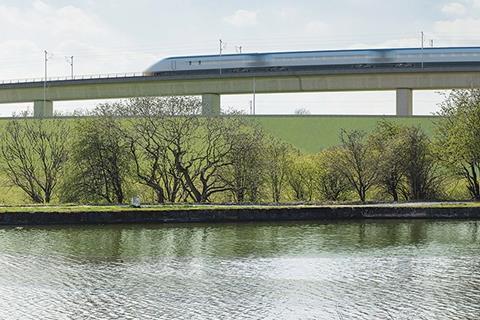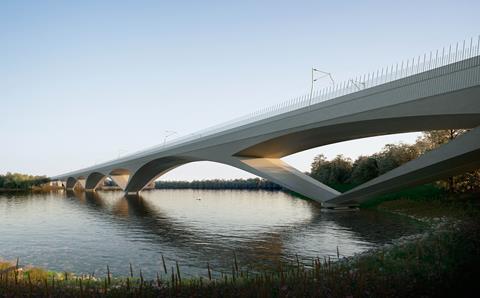Christoph Brintrup, head of landscape design at HS2 explains the process behind ensuring HS2 considers its urban and rural surroundings

HS2 will pass through an incredibly diverse landscape in terms of character, quality and usage, including urban, semi-urban, rural and historic areas.
HS2 therefore poses challenge but also great opportunities for designers: to create a connected space that is driven by local context and brings community and economic benefits, delivers landscape beauty wherever possible, meets rigorous environmental standards, is built to last and adapt to change, and is a source of national pride by adding to our cultural and natural heritage,
To achieve all this, HS2’s Landscape and Design teams have worked extensively with an independent panel of world-renowned designers, landscape and sustainability/ecology specialists to develop a blueprint for how landscape design must be approached by the wide range of contractors who are designing and building the various components of the network - from track and stations to bridges tunnels and cuttings.
Rather than a ‘consistent landscape design’, HS2 is aiming for a ‘coherent design approach’ that is applied route-wide. This means designs will respond to local contexts, landscape quality and character, whilst focusing on the design principles of conservation, enhancement, restoration and transformation.
In order to achieve the benefits that we are aiming for and to create the high-quality green spaces, water bodies and other environmental features, we require an integrated design that allow our places to be characterful, beautiful, healthy as well as highly functional.

Restoring and enhancing the environment
Announced this week, HS2 will create a green corridor of woodlands, habitats and community spaces alongside the railway. This includes planting up to 7 million trees and shrubs during Phase One of the project, from London to the West Midlands. There’ll be a mix of native species, tailored to each location, such Oak, Silver Birch, Holly, Field Maple and Wild Cherry.
Around 9 square kilometres of new woodland will be planted between London and Birmingham as part of the first phase of HS2, to help reduce the visual impact of the line and create valuable new wildlife habitats.
One of our key aims is to improve biodiversity and create new habitats linking up formerly isolated woodland areas. It will also increase CO2 absorption which will absorb many hundred thousand tonnes of carbon dioxide from the atmosphere.
Every effort is being made to avoid losses of ancient woodland, but there are some instances where design constraints mean it’s unavoidable. To partially compensate for that, HS2 will use a range of measures such as creating new mixed deciduous woodland which incorporate reclaimed ancient woodland soils, and enhancing remaining ancient woodland.
Salvaging and relocating ancient woodland soils will help us retain some of the biodiversity associated with ancient woodland seeds, bulbs, fungi and invertebrates.” Says Brintrup “Where we have to plant new woodland, it will include young, native species, planted wherever possible to reflect the characteristics of the woodland being lost. But we’re going further - where ancient woodland soils containing seeds are moved to new locations, we’ll encourage natural regrowth of trees over time by temporarily planting fast-growing trees to provide the shady conditions which encourage germination and growth of buried seeds. They’ll eventually be removed once the native species start to mature.

Integrating the railway into the landscape
Landscape design is also playing a role in helping to blend HS2 into the landscape, and making new structures such as bridges sympathetic to their environment. Best practice from around the world has been researched and approved by an Independent Design Panel, and the principles being incorporated into the design of HS2 structures such as green bridges and viaducts.
One example is the Colne Valley Viaduct, which at just over 3km long will be one of Britain’s longest. Rising between 10m and 15m above ground level, the viaduct is located in an area containing water and woodland features, including lakes and the River Colne. To guide developers, concept designs were developed, using the Landscape Design Approach as a guide, alongside an iterative process including design workshops, design reviews, 3D models and engagement with affected communities and stakeholders. The emerging viaduct design from the developer is based on the original concept and is now tested further against the various project requirements.
Using Landscape Design to boost wellbeing and local economies
HS2’s design and build contractors are being asked to factor Health & Wellbeing into all design decisions. Particularly attention will be given to communities which lack local green spaces and facilities for physical activity.
“It’s no secret that physical activity can boost self-esteem, mood, sleep quality, energy and general wellbeing.” says Brintrup, “HS2 is a great opportunity to look how good landscape design can improve opportunities for physical activity in the communities through which it passes. We’re looking at everything from creation of open waterways and walking trails to ‘architectural’ landscape features which encourage people to get out and about, visit and enjoy.”
Using Landscape Design to improve the passenger experience
As well as the view of HS2, Landscape Design is being used to curate the views from HS2 – i.e. how passengers will experience their journey.
“Landscape Design is fundamentally about the complex relationship between people and place, so the views from inside the train - celebrating the environment through which the passenger is passing - is as important as the experience that people have when viewing HS2 from the outside.”
Travellers often use visual cues to navigate the progress of their journey, and this is an important part of the passenger experience. So HS2 has been using VR simulations to explore how landscape features with all its structures, enclosed and open spaces can enhance the experience.
HS2’s Landscape Design team are working with the visualisation team at Arup to study mapped assets along the route and identify Zones of Theoretical Visibility (ZTV) both with and without proposed design features. . The interfaces between the individual design components such as noise barriers, tunnels, earthworks and catenary masts (just to name a few) can be tested through tools such as 3D Virtual Simulation. It gives designers the opportunity to merge and consolidate a number of design elements and to test them before they are built. This process has also helped identify locations for where specific design considerations might need to be considered, to create views and visual experiences that will be meaningful whilst travelling at high speed and the extent to which features in the landscape may be perceived at various distances in proportion to speed (a concept of ‘motion parallax’).
So, whilst the start of construction is months away, landscape design is already playing an important role in creating the most sensitive rail network which the UK has ever built, and one which over time will enhance the environment and, where it can, offer benefits to the communities through which it passes.



























No comments yet